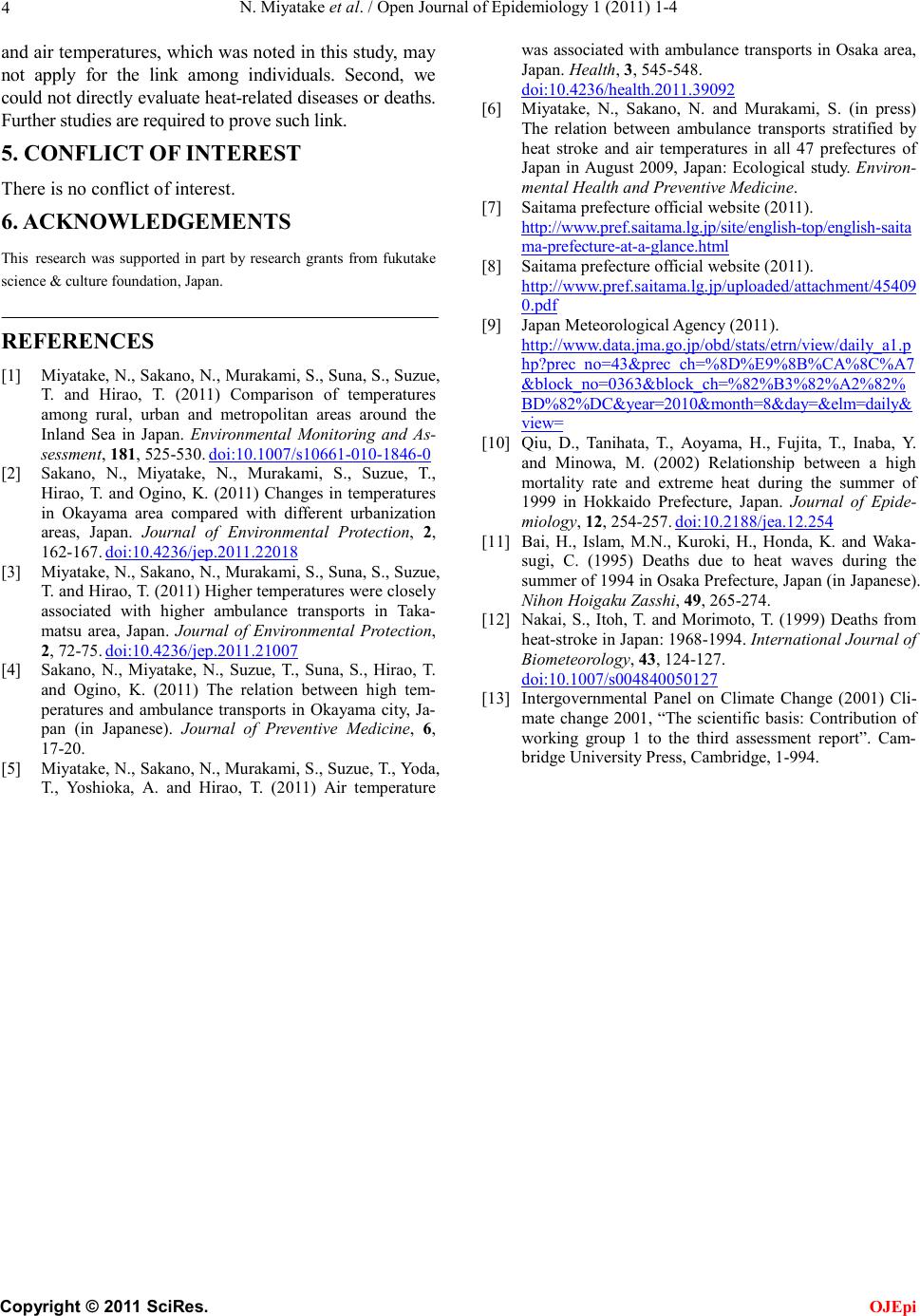
N. Miyatake et al. / Open Journal of Epidemiology 1 (2011) 1-4
4
and air temperatures, which was noted in this study, may
not apply for the link among individuals. Second, we
could not directly evaluate heat-related diseases or deaths.
Further studies are required to prove such link.
5. CONFLICT OF INTEREST
There is no conflict of interest.
6. ACKNOWLEDGEMENTS
This research was supported in part by research grants from fukutake
science & culture foundation, Japan.
REFERENCES
[1] Miyatake, N., Sakano, N., Murakami, S., Suna, S., Suzue,
T. and Hirao, T. (2011) Comparison of temperatures
among rural, urban and metropolitan areas around the
Inland Sea in Japan. Environmental Monitoring and As-
sessment, 181, 525-530. doi:10.1007/s10661-010-1846-0
[2] Sakano, N., Miyatake, N., Murakami, S., Suzue, T.,
Hirao, T. and Ogino, K. (2011) Changes in temperatures
in Okayama area compared with different urbanization
areas, Japan. Journal of Environmental Protection, 2,
162-167. doi:10.4236/jep.2011.22018
[3] Miyatake, N., Sakano, N., Murakami, S., Suna, S., Suzue,
T. and Hirao, T. (2011) Higher temperatures were closely
associated with higher ambulance transports in Taka-
matsu area, Japan. Journal of Environmental Protection,
2, 72-75. doi:10.4236/jep.2011.21007
[4] Sakano, N., Miyatake, N., Suzue, T., Suna, S., Hirao, T.
and Ogino, K. (2011) The relation between high tem-
peratures and ambulance transports in Okayama city, Ja-
pan (in Japanese). Journal of Preventive Medicine, 6,
17-20.
[5] Miyatake, N., Sakano, N., Murakami, S., Suzue, T., Yoda,
T., Yoshioka, A. and Hirao, T. (2011) Air temperature
was associated with ambulance transports in Osaka area,
Japan. Health, 3, 545-548.
doi:10.4236/health.2011.39092
[6] Miyatake, N., Sakano, N. and Murakami, S. (in press)
The relation between ambulance transports stratified by
heat stroke and air temperatures in all 47 prefectures of
Japan in August 2009, Japan: Ecological study. Environ-
mental Health and Preventive Medici ne.
[7] Saitama prefecture official website (2011).
http://www.pref.saitama.lg.jp/site/english-top/english-saita
ma-prefectu re-at -a- glanc e.ht ml
[8] Saitama prefecture official website (2011).
http://www.pref.saitama.lg.jp/uploaded/attachment/45409
0.pdf
[9] Japan Meteorological Agency (2011).
http://www.data.jma.go.jp/obd/stats/etrn/view/daily_a1.p
hp?prec_no=43&prec_ch=%8D%E9%8B%CA%8C%A7
&block_no=0363&block_ch=%82%B3%82%A2%82%
BD%82%DC&year=2010&month=8&day=&elm=daily&
view =
[10] Qiu, D., Tanihata, T., Aoyama, H., Fujita, T., Inaba, Y.
and Minowa, M. (2002) Relationship between a high
mortality rate and extreme heat during the summer of
1999 in Hokkaido Prefecture, Japan. Journal of Epide-
miology , 12, 254-257. doi:10.2188/jea.12.254
[11] Bai, H., Islam, M.N., Kuroki, H., Honda, K. and Waka-
sugi, C. (1995) Deaths due to heat waves during the
summer of 1994 in Osaka Prefecture, Japan (in Japanese).
Nihon Hoigaku Zasshi, 49, 265-274.
[12] Nakai, S., Itoh, T. and Morimoto, T. (1999) Deaths from
heat-stroke in Japan: 1968-1994. International Journal of
Biometeorolog y , 43, 124-127.
do i:10.1007/s 004840050127
[13] Intergovernmental Panel on Climate Change (2001) Cli-
mate change 2001, “The scientific basis: Contribution of
working group 1 to the third assessment report”. Cam-
bridge University Press, Cambridge, 1-994.
C
opyright © 2011 SciRes. OJEpi